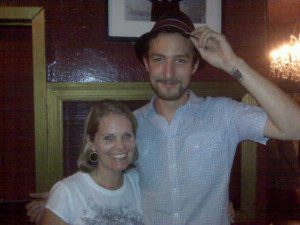I was introduced to Frank Turner in 2008, shortly after his first full length album, Love Ire and Song was released. The minute I heard “Substitute” I was hooked. And not in an “I need a cup of coffee every morning,” sort of way, I mean in an “I need an intravenous drip to roll around at my side” kind of way.
My first Turner show was at the Fillmore in San Francisco, September 2009. He was the opening, opening, opening band for The Gaslight Anthem. My husband and I planned for this one months out. We got tickets and a hotel room. We even asked my parents to drive down from Idaho to watch our kids. At the time my daughter was six and my son was four. The show was just Turner and his guitar singing to a small crowd of people, but I was there in the front, singing and dancing along to every song. Loudly. It was incredible. My husband and I even managed to accost him coming out of the bathroom later to fawn over him. A brilliant night.
It’s now been six years since that night and Mr. Turner has since put out four more highly successful records. My attendance at his shows are now in the double digits, one even at that same venue two years ago in San Francisco, which he managed to sell out as the headliner. But this post is not about me, it’s about the little girl who has grown up drenched in the poetry of Turner’s music.
My daughter is now 12 and in middle school. Having worked with middle school kids for over 20 years, I am very aware of their search for identity. The lessons, though, that we’ve been preaching as parents still surface. As a little girl, she begged for Turner’s music in the car, sang along with every lyric, (carefully omitting certain words), and danced along side me. She has since found her own loves in the musical pop world of teenagedom, but still she pilfers my Turner shirts, and loads his music on her Spotify playlists. So, when I heard he was coming to Sacramento, I couldn’t wait to take her.
We got there early, planted ourselves in the front and waited. “I’ve never been this close to a stage before, mom.” Well, she’s never gone to Turner show with me. When Turner burst into his first set, I watched her watch others, especially me. When I exploded in dance, throwing my arms in the air and belting lyrics, she was right there with me, mimicking my excited behavior.
This show had everything a young fan could want: crowd surfing, hand clapping, audience participation. At one point Turner even made the entire venue sit down, so we could jump up synchronously at the perfect point. It was crazy, sitting on a dirty floor, smashed next to sweaty people, but we all did it. The smiles radiating from my daughter’s face made this by far my favorite Turner show.
We stuck around to meet him after, wanting her to have that experience. Turner is one of the nicest musicians you’ll ever meet, always gracious to his fans. We could tell how tired he was, but still he took the time to let us snap photos and chat for a bit.

My love for live music is something I’m proud to pass on to my daughter, but more than anything, I know I’ve found my front row dancing partner.





